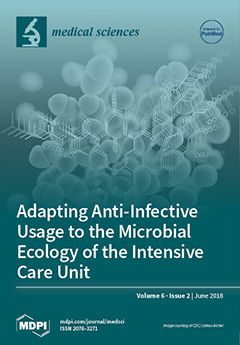Breast cancer is broadly sub-divided into hormone responsive and non-hormone responsive subtypes. Estradiol has been associated with hormone responsive breast cancers. There is, however, a paucity of information on the role of sex hormones, gonadotropins, and thyroid hormone in non-hormone responsive breast cancer.
[...] Read more.
Breast cancer is broadly sub-divided into hormone responsive and non-hormone responsive subtypes. Estradiol has been associated with hormone responsive breast cancers. There is, however, a paucity of information on the role of sex hormones, gonadotropins, and thyroid hormone in non-hormone responsive breast cancer. This study aimed to determine differences in the serum levels of sex hormones, gonadotropins, thyroid hormones, and endocrine disruptors (lead, cadmium, and arsenic) in Nigerian women with hormone responsive and non-hormone responsive breast cancers. Seventy-nine non-pregnant women aged 28–80 years with histologically confirmed breast cancer were recruited, pre-therapy, into this cross-sectional study. They comprised 52 premenopausal women and 27 postmenopausal women recruited from the Surgical Oncology Clinic of the Department of Surgery, University College Hospital, Ibadan. Comparison of biochemical parameters were based on the positivity (+) and negativity (−) of estrogen receptor (ER), progesterone receptor (PR) and human epithelial receptor-2 (HER-2). Estradiol, progesterone, follicle stimulating hormone (FSH), luteinizing hormone (LH), free thyroxine (FT
4), free triiodothyronine (FT
3), and thyroid stimulating hormone (TSH) were determined using enzyme immunoassay (EIA). Serum lead, cadmium and arsenic were determined using atomic absorption spectrophotometry (AAS). Expression of ER, PR and HER2 were determined using immunohistochemistry. Data was analyzed using Mann-Whitney
U-test and multiple regression, with
p < 0.05 considered as being statistically significant. Estradiol and progesterone were significantly higher in breast cancer participants with ER
− and PR
− compared with those with ER
+ and PR
+ breast cancer (
p < 0.05). Follicle stimulating hormone and LH levels were significantly higher in participants with ER
+ and PR
+ breast cancer compared with participants with ER
− and PR
− breast cancer (
p < 0.05). Arsenic was inversely related with TSH in premenopausal participants with ER
− and PR
− (
β = −0.305;
β = −0.304, respectively). Sex hormones and gonadotropins appear to be involved in the pathogenesis of triple negative and luminal breast cancer, respectively.
Full article




